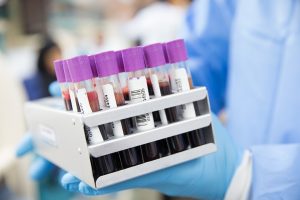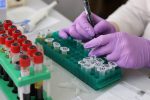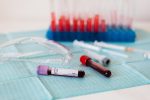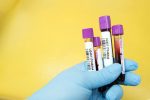
Even though we always say that future phlebotomists should not be worried about their job prospects, being that the demand for qualified phlebotomists has never been higher, it is still important to spend some time making your resume perfect.
Your resume has to be made so great that it helps you to stand out from the crowd.
Simply stating the training course you took will not be enough as numerous candidates are fighting it out for the best jobs.
Phlebotomists are professionals who can work in a variety of different types of organizations and each of them has its own requirements when different personal qualities are in question.
So as to be attractive to a possible employer, you need to make sure your resume is a precise reflection of what you can offer.
Writing the ideal resume is no an easy task, so we provide you with some tips that you can find useful when making your phlebotomy resume.
Page Navigation
What Should I Include in My Phlebotomy Resume?
The main aim of our article is to tell people what a good phlebotomy resume should include.
That is why we will offer your a basic outline and what has to be filled in.
You are supposed to keep your resume updated and add any accomplishments or extra skills once you gain them.
All in all, the article will tell you how you can make your resume be more attractive than the other candidate’s resumes.
Phlebotomist Resume Objective
As experts suggest, the best resume should start out with an objective, which has to be short but get straight to the point.
That way you will leave the first impression on your potential employer.
Long and wordy resumes may cause your potential employer to become disinterested and move on.
The main objective of a phlebotomy resume should cover two significant things:
- It should include the type of experience you hope to have as a phlebotomist in a sentence or two.
- It is supposed to give your potential employer an idea related to your goals within a phlebotomy career, which can be personal. Your goals may be to help many people or to jumpstart a career as a nurse.
This a good example of a strong objective statement for a phlebotomy resume:
I am looking for a challenging and rewarding phlebotomy technician position. My goals are to apply my learned skills and experience and to advance in my career.
Everyone’s objectives will be different, but our advice is not to write more than three sentences.
You have to mention what makes you desire to be a phlebotomist and why.
Summary of Qualifications
There are also resumes that may include a summary of qualifications instead of an objective statement.
Which of these two you will write depends only on you.
We highly suggest that you use a summary of qualifications when applying for a specific job at a particular place.
That way you will emphasize the fact that your phlebotomy qualifications match with that specific job’s description.
Through a summary of qualifications, you will show your strengths and skills and emphasize that they are exactly what the employer is looking for.
Here is an example of a job posting followed by a strong summary of qualifications.
- Job posting: In need of a strong team player to work in a hospital environment. He/she should have skills in venipuncture, finger sticks, and blood collection procedures. CPR-certified is an advantage.
- Summary of qualifications: Experienced in venipuncture, successful in using finger sticks, butterfly needles, and syringes. Excellent in working with others and working under pressure. Completed National Phlebotomy Certification exam as well as CPR training.
A summary of qualifications is the option through which you can let the employer know you are a perfect fit, and why.
Including Your Strengths and Skills
If you do not have any prior phlebotomy experience, it can make your resume look poor, but you should not be worried.
Your work history in your resume can be replaced by including your strengths and skills.
Furthermore, the skills that you mention do not have to be strictly related to a career in phlebotomy.
You can always mention “punctual”, which can turn out to be quite appealing to an employer.
You should include whatever you think makes you unique and what can help you stand out among other possible employees.
Some examples of skills can include:
- Knowledge of medical terminology
- Knowledge of different venipuncture methods and sites
- Energetic
- 200+ successful blood draws
- Team-player
- Bilingual (Spanish and English)
- Highly organized
It is worth mentioning that when you write down your list of skills, you should not mention things that every person looking for this job will mention.
You should not include how many blood draws you have done or what you know about medical terms and the anatomy of the human body.
Your resume has to stand out from everyone else’s, and more personal skills and strengths should be included.
That is what can make a possible employer hire you over someone else.
Past Work Experience
Those people who have prior work history will probably have an advantage as most employers would want to know where you have worked before.
It is important that you not just state previous places of employment without all the duties and responsibilities that you performed while working there.
Our advice is to give as many details as you can about your role in your previous jobs.
In case you have worked for a medical facility as a phlebotomist, the duties you should include might be:
- Performed routine blood draws
- Extremely familiar with phlebotomy equipment
- Skilled in using butterfly needles
- Verified collection of different specimens
- Communicated with doctors and patients about their orders
Of course, all the responsibilities from past jobs that you mentioned should be unique to you, and the best way is to avoid using generalities that each person interested in a phlebotomy job will mention.
You should also include internships.
Your list of work history should start with the most recent experience first.
How to Improve a Phlebotomist Resume with No Experience
People who are starting out as a phlebotomist cannot include work history and experience in their resume, but that does not mean that they will not be a good match for certain jobs.
Even though many employers will look for an applicant’s work experience, being that previous jobs can show whether you are a dedicated worker, you may come across employers who do not require you to have experience in the healthcare industry.
So as to be attractive, besides the fact you have not worked before, you will have to perform many successful venipunctures throughout your training.
The training programs have a different number of venipunctures that have to be done so that a student can pass the training, and it is usually over 100.
This fact can be used in your resume, but will not be of great help, as everyone has to go through similar training procedures and will have it mentioned in their resumes.
Most hospitals and medical facilities would prefer hiring phlebotomists that have at least a little experience and if you are having trouble getting hired after training, there are numerous ways to gain experience:
- Volunteer: As a new phlebotomist without any prior experience the best way of getting one is through volunteering. You will reach experience quickly. Numerous hospitals and clinics are in need of phlebotomists, as well as other different organizations. It is true that they will not pay you, but this is an ideal chance for gaining experience and adding to your resume. Phlebotomy volunteers are also needed in nursing homes, blood banks, the Red Cross, and veterans’ hospitals.
- Internship: You can also try gaining experience through an internship in hospitals and clinics. Internships are given to training graduates and are usually unpaid.
- On-the-job training: Pople without any prior experience in phlebotomy can try their luck with medical facilities that accept people who agree to on-the-job training. This is the occasion when you work with a supervisor for a period of time until you reach enough experience to start working alone. what makes this different from internships is that on-the-job training can offer you a salary, which may be limited at first.
- Hospital training: Hospitals are in constant need of phlebotomists and they even offer their own training programs. The programs are created with the aim to equip students with appropriate knowledge. plus, they hope that these students will stay to work in their facilities. Sometimes, these programs are made to be specific to their facility, including their own safety rules and procedures. Students who finish this program are more likely to get hired right away by that hospital.
For novice phlebotomists, the ‘work experience’ section of the resume is the hardest to fill in, so we highly suggest trying one of these options and add as many hours as they can to make the resume better.
Where Did You Complete Your Training?
The significant section of your phlebotomy resume has to focus on where you got your training, and employers are always attracted by those individuals who have finished an accredited program.
What you are supposed to do is to list the school or program you attended, and when you have finished it.
Plus, it is suggested to add any extra certifications that you might have.
It is true that not all US states require that phlebotomists complete a certification exam, but even though they do not, our advice is to finish it.
The reason for this is that a certificate in phlebotomy will help you to stand out from the competition.
According to the statistics, those phlebotomy students who receive certification are often picked above other candidates.
Additionally, they get a higher salary than a technician who is not certified.
The resume has to include all the other certifications you might have, as well as any extra qualifications.
The order is the same as with your work experience.
You should list your most recent training or schooling experience first.
It is important to include when you graduated high school and the name of the school.
References
At the end of your resume, although it is not always necessary, you can include two or three references.
References should be the last thing to add after all other important information and details are included.
You may be applying for a job that already has an application form to be filled out.
There you may find a spot to list your references.
If you add references, you need to let these people know that you include them.
Once they get a phone call or email from an employer, they should not be confused.
Of course, you will not tell them what to say, but your reference has to be a person you trust, who will be honest about your skills.
A reference can be anyone, but it is better not to be a family member.
The best person can be someone you have shared a work experience with in the past.
Previous bosses or managers can be ideal candidates for a reference as they will give a description of what you are like in a work environment.
What Not to Include in Your Resume
We have only spoken about different sections to include and put them together in your resume, but we did not mention things that should be avoided in creating a good resume.
It is known that some little traps can easily become big red flags for employers and we want to draw your attention to these mistakes, so as not to make them.
Our suggestion is to avoid these in your resume:
- Do not use language in the first person, as it is considered unprofessional. This can may make your resume look bad.
- Simple is better. Do not fall into the trap of using complicated words. Your possible employer probably has a number of resumes to look at, and complicated resumes will not be attractive to him/her. It is always better to choose words and phrases that are clear and concise.
- Do not focus on using medical terms as you will not get any extra points. Our advice is to use the right language for the position you want. Keeping the language as simple as possible is essential.
- Never lie about your experiences listed on your resume. It is suggested to always mention the real past jobs, certifications, and education. The reason for this is that certain employers do a background check before they consider hiring you and they will find out that something is wrong with your resume. On these occasions, you definitely will not get the job.
What’s the Perfect Format for a Phlebotomy Resume?
Nobody can tell you the ‘perfect’ format for your resume.
But, still, we consider it better to make it in the order we have listed out.
Here are a few concrete things that you must keep in mind when formatting is in question:
- Your objective statement or summary of qualifications has to be at the top, as this is the first thing that your possible employer will read and will get a better idea of who you are. By setting it first, you make it easy to find it right away.
- As we have already said, your work experience and education history should start with the most recent examples first.
- You should highlight the things you consider the best about yourself and your career and put them closer to the top of the resume. This is important as HR professionals have a lot of resumes to go through when hiring and will probably read only the top half of your resume. That is why it has to show the best parts of your work and education. if these facts attract an HR professional, he/she will proceed with reading the rest of your resume.
- Those who have no work experience should put education/training before their work history.
- Your resume has to match the job you are applying for and you should never send the same resumes to different hospitals. Prior to submitting it, you need to make quick changes so as to make it fit the job description. That way the possible employer will know that you are interested in their position, which will leave a better impression.
Does it Matter What My Resume Looks Like?
As you have probably concluded from the article, you can make your resume look better by adding various things.
The most important is that your resume differs from all the rest.
There are numerous ways to design your resume, but whatever you do, make it personal to you.
Some applicants use a template, which can be helpful, but you need to choose a template that will not only list your strengths and experience.
We would like to mention more things that you can keep in mind which will give your resume a little ‘boost.’
You can either choose one or two of these tips:
- You should choose a theme that will make you noticed, as well as professional. Calm colors can make your resume look just different from others. If you wish, you can also add a subtle touch. Do anything different, and never use a standard white document.
- Your contact information should be easily visible at the top of the resume. It is not the best solution to put contact information at the end of the resume. Your contact information can be in the corner or as the first thing on the page. That way the employer will be able to see it easily.
- Nowadays, people tend to apply a more modern approach, by including a picture and personal details. There are employers who will appreciate this approach. Through these kinds of resumes, they find out more about a candidate before calling him/her in for an interview.
All in all, you do not have to follow all these tips, you can design your resume as you wish.
Make sure it is not too confusing, but include colors to get noticed.
The demand for phlebotomists is huge, but at the same time, there is a huge number of people applying for these jobs.
That is why your resume has to show why you are a better candidate for a job than someone else.
If phlebotomy is the perfect field for you, the right resume can help you get a job sooner and start your career as a phlebotomy technician.








